Wednesday 15 February 2017
White: D. Heath (145) - Black: K. Nevols (134)
In life, we all need some luck - so it is over the chessboard. This is the great escape.
1. d4 d5
Having now decided to abandon the Kings Indian Defence after the latest shattering defeat (at the same venue), it was my intention to defend using the Queens Gambit Declined - so I was preparing to meet 2. c4 with 2. .. e6.
2. Nf3 Nf6
3. e3
In QGD positions, often it is difficult for Black to deploy the queen's bishop after blocking it with e6 - so I take the opportunity to develop it. A more cautious 3. .. e6 would have been wiser.
3. ... Bg4
4. h3
White targets the bishop.
4. ... Bh5
5. g4 Bg6
6. Ne5
Now 6. .. e6 is best, although I considered 6. .. Nbd7 7. Nxg6 hxg6 leading to a pawn set-up which I have come across from playing the Scandinavian.
6. ... Be4??
But this is a blunder. Black's fourth Bishop move out of six does White's work for him - White now gains a winning position by force very quickly. My intention was to mess up the White pawns on the kingside, but I had completely overlooked the following sequence.
7. f3 Bg6
8. h4 h5?
Another early error, caused by bad memories of an early game at Hastings where I played h6 and got the pieces all blocked in (Game Three). 8. .. h6 would have been better.
9. Nxg6 fxg6
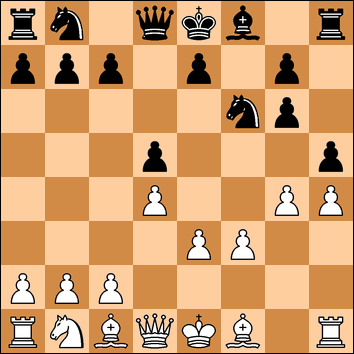
Black is now lost. Those White squares around Blacks' king are an obvious target and cannot be defended. White need only line up the queen and bishop along the b1-h7 diagonal to hit the g6 point, and couple it with c4 and Nc3 to hit the d5 point and it will be curtains for Black.
10. Bd3 Kf7
11. g5 Ne8
12. c4
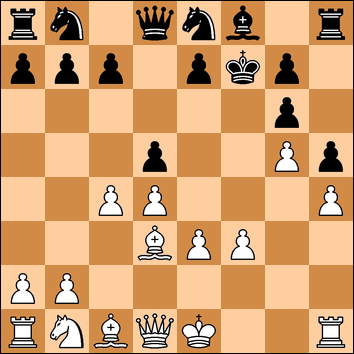
So now I invested a lot of time in a mega think. Black's position is simply awful. No pieces are developed, the king is dislodged, the squares around him are weak, the king's bishop and rook can only dream of one day entering the action, and White has a clear plan of attack following c4 with Qc2 or Qb3 and Nc3.
12. .. dxc4 13. Bxc4+ e6 14. Qb3 Qc8 15. d5! is horrible.
12. .. c6 13. cxd5 Qxd5 14. Nc3 with either Qc2 or Qb3 is not a lot better.
I even considered a wild 12. ... e5?! - the plan being 13. dxe5 Bb4+ freeing the f8 square for a king retreat.
The best the computer can do is to let a pawn go with 12. .. c6 13. cxd5 cxd5 14. Nc3 e6 15. Qc2.
I tried to consider how I could cover all the weak squares - g6, d5, b7 - and try to match that with some sort of counter attack, or at least an imaginary counter attack - in the hope that White might be distracted.
12. .. Qd6
And I came up with this move - to both defend the g6 point, and make the threat of Qg3+. The time limit was the usual 35 moves in 75 minutes, and then 15 more minutes for the rest, and already I was down to 34 minutes left for 23 moves. Well, I consoled myself, at least I will get an early night.
Now White should play 13. cxd5 and if 13. .. Qxd5 then 14. Nc3 Qe6 (14. .. Qd6?? 15. Qb3+) 15. Ne2! and Nf4 is coming. My plan had been 13. cxd5 Qg3+ but that was far as I got. My hope was that the Qg3+ illusion would convince him to play 13. f4 which would block that square and weaken any subsequent e4 push.
13. f4
OK, so that worked. Now a further ten minute think to see how I could cobble together some sort of defence.
13. ... Qb4+
14. Nc3 c6
I now had 18 minutes left for 21 moves!! My plan was to try to get as many pieces as I could to defend the d5 point and hope to distract him from the fact that he could simply win by targeting g6.
Now best for White is 15. Qc2 Qd6 16. Qb3 Qd7 17. cxd5 - the computer rates this as +2.04.
15. cxd5 cxd5
16. a3 Qd6
17. Bd2?!
The first small sign that White is going wrong. 17. Qb3 wins a pawn straight away. At the time, I also struggled to see an answer to 17. Nb5 although 17. .. Qc6 hangs in there. Better to keep the knight on c3 where it attacks d5.
I did not understand 17. Bd2 and assumed the plan was to bring the rook to the c-file. However, this gives me a breather to improve the defence of d5.
17. ... Nc7!
18. Qf3
The queen goes the wrong way! While this attacks d5, it lefts b7 off the hook.
18. ..... e6
Now that lateral defence of g6 is no longer needed, this move can defend d5 as well as prevent an f5 push.
The computer now recommends admitting the mistake and going back with 19. Qd1 but a human is not likely to do that.
19. O-O-O?
But this is a mistake - castling kingside - 19. O-O is far better and keeps up the pressure. White then has a choice of some glorious plans - e4, b4, doubling the rooks somewhere - he is spoilt for choice.
Castling queenside does not end the advantage - White is still much better - but he is not as better as he was. He has wasted a lot of time and now I get the chance to add another piece to the defence.
19. .... Nc6
20. Kb1
Another surprise but not as bad as it looks. Maybe 20. Rde1 is an improvement.
20. ... .. Ne7!
This knight is heading for the f5 square. I now had 13 minutes left for 15 moves.
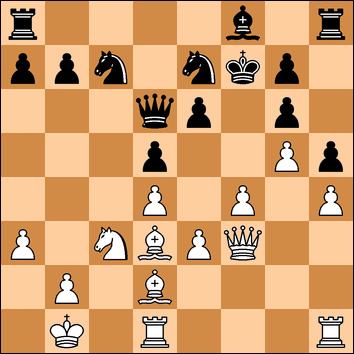
21. e4 dxe4
22. Nxe4
If 22. Bxe4 Black could try 22. .. Nf5 23. Bc1 Rb8 then if 24. Bxb7 Nxd4 25. Qe4 Qb6 hangs on.
22. .... Qb6
23. Bb4 Nf5
24. Bc5 Bxc5
25. dxc5 Qc6
Nine minutes left for ten moves but now I am thinking I might get out of this alive. One pair of bishops have gone, my knights are well placed, and I can now develop the rooks. The main problem is the weakness of the e6 pawn and, thinking long term, the majority White has on the queenside.
26. Qe2 Rhd8
27. Bc4 a6
28. Rhe1 Rxd1
29. Rxd1 Nd5
With four minutes left for six moves, I still had no time to pat myself on the back. But now the position is even.
30. Rf1??
White blunders ...
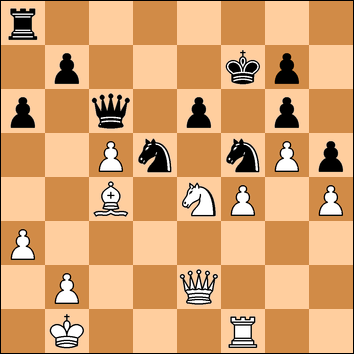
30. ..... Re8??
... and so does Black. All I could think of in my limited time was defending key points - such as the pawn on e6.
I cannot say if I had more time whether I would have seen 30. .. Nde3! but this turns the tide. 31. Ng3 Nxf1 32. Nxf5 gxf5 33. Qxf1 Qxc5 and White is now losing by an exchange and a pawn.
While White was thinking, I now saw the move Nde3 (one move too late) but did not have time to calculate whether it was any good - and it was too late anyway as White puts a stop to it.
31. Rf3
Now best for Black is the remarkable 31. .. b5! I did not see this at all. If 32. cxb6 then simply 32. ... Nd4. If 32. Bb3 then the bishop is dislodged from defending the e2 square in the upcoming sequence. White would have to play 32.Bd3.
31. .... Nd4
I had seen the combination coming up but assumed it led to a draw.
32. Nd6 Qxd6
33. cxd6 Nxe2
34. Bxe2 Rd8
35. Rb3 b6?
With one minute left, I end any chances of a surprise win. I had rejected 35. .. b5 because of 36. a4 but then 36. .. Rxd6 37. axb5 axb5 38. Rxb5 Nxf4. Black is a pawn up but White has the bishop and a passed b-pawn so has good chances of at least a draw.
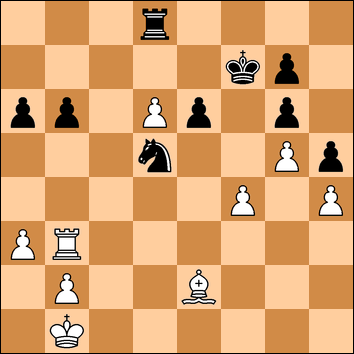
I was just glad of meeting the time control and also of now being likely to get the draw.
36. Bxa6 Rxd6
37. Rf3 Ne7
Back to f5 - where I was confident the draw was in hand.
38. Rc3 Nf5
39. Rc7+ Kf8
40. Bb5 Nxh4
41. Rc8+ Ke7
I considered 41. .. Kf7 with the aim of getting the king round to h7 but did not trust the position after 42. Be8+. There is also the danger, after moving the king to h7, of getting trapped if the bishop could work its way to f7 and the g8 square.
42. Re8+ Kf7
43. Rc8
Black could now play 43. .. Ng2 where White could choose between 44. Be8+ Ke7 45. Bxg6 Nxf4 46. Rg8! or just 44. Rc4.
43. ..... Ke7
But I was happy with a draw,
44. Re8+ Kf7
45. Rc8
Draw agreed - an entertaining game and a close run thing.
Maidstone v Swale
Cristian Ilinca (154) 1/2-1/2 Keith Hyde (167)
Barrington Beavis (148) 0-1 Trefor Owens (172)
David Heath (145) 1/2-1/2 Keith Nevols (134)
Ian Clark (141) 1-0 Peter Blundell (120)
Douglas Smith (132) 1-0 Tyrone Jefferies (116)
Peter Dirmauskas (99) 1-0 Andrew Gillard (113)
Maidstone 4-2 Swale
No comments:
Post a Comment